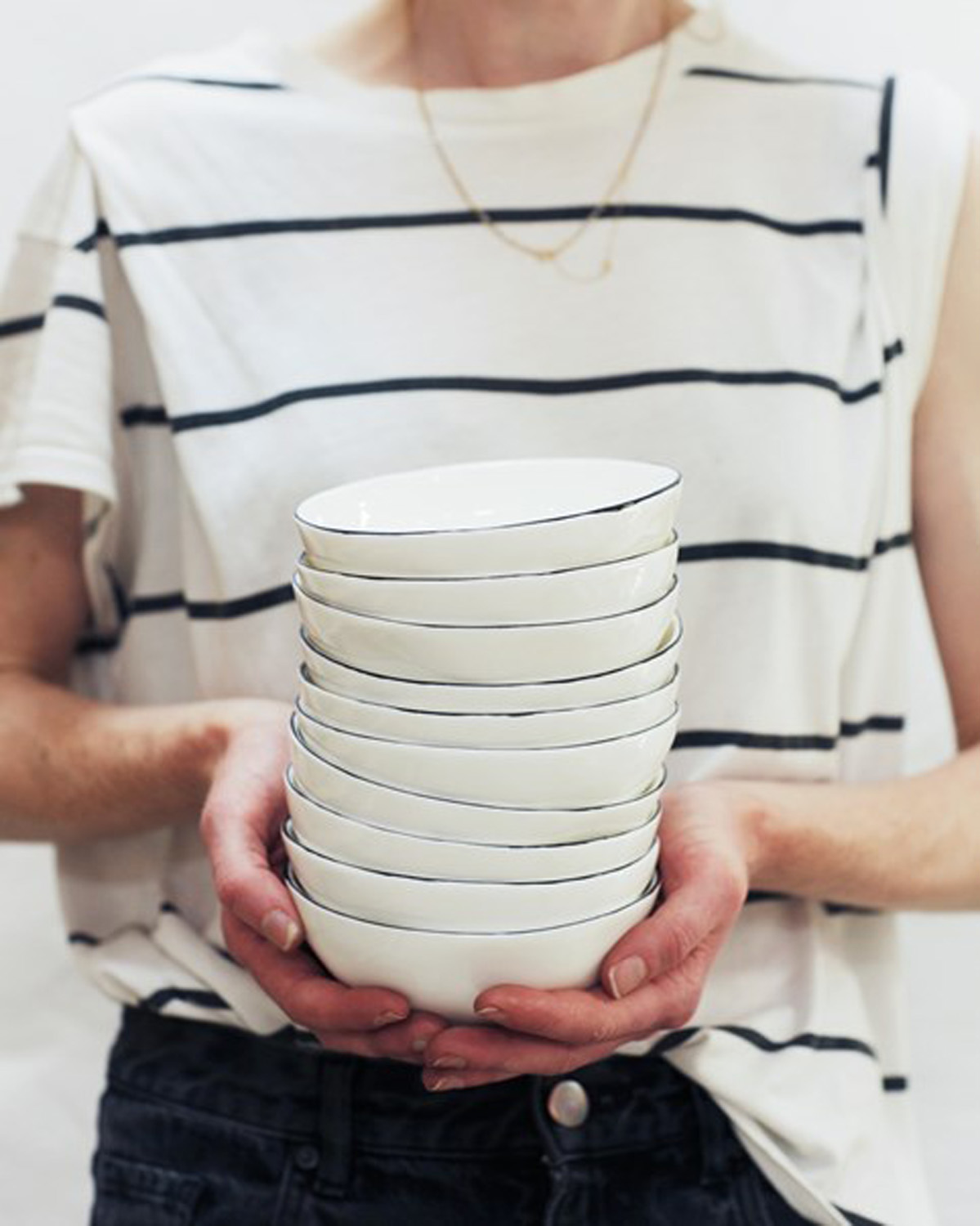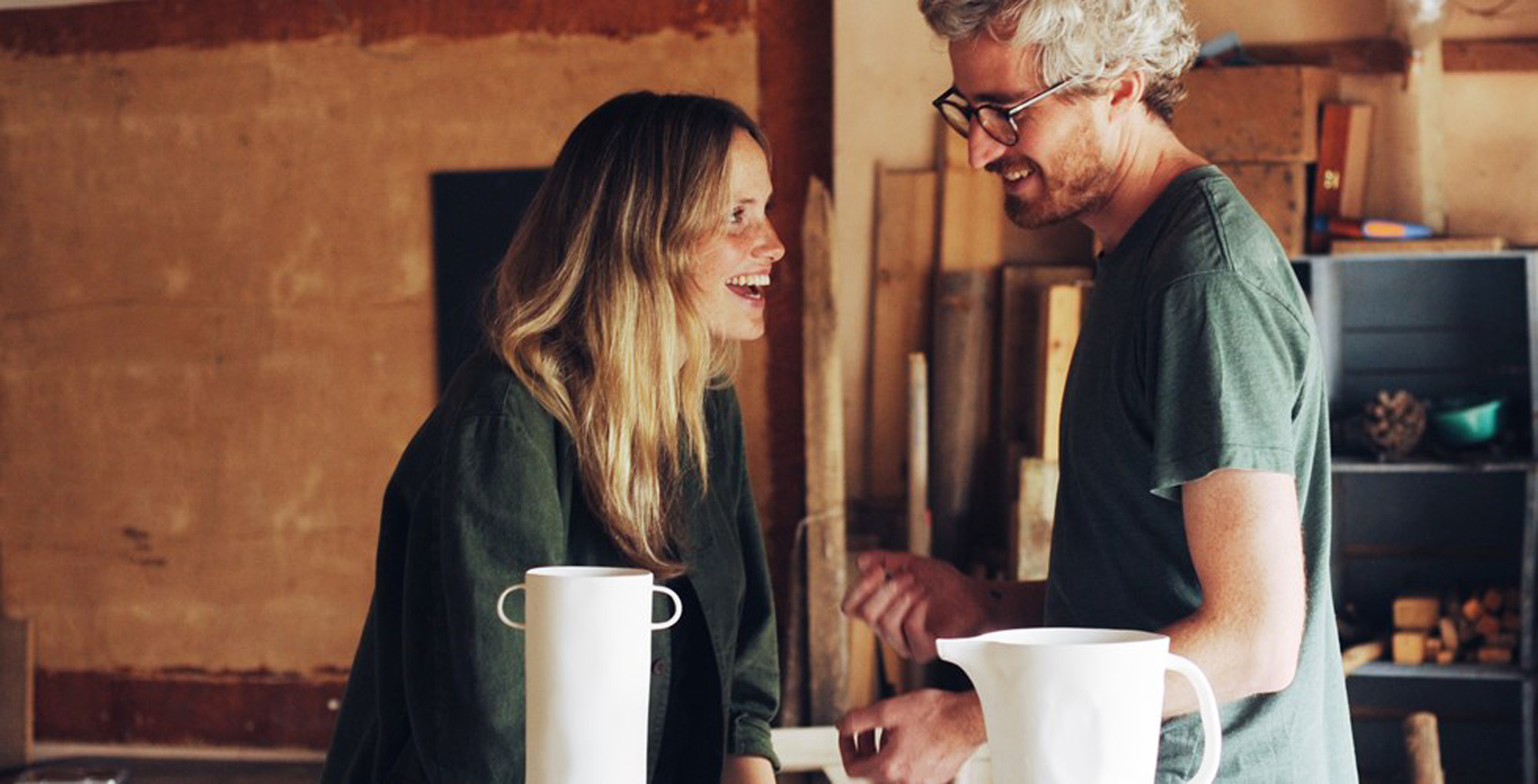Cath and Jeremy Brown, co-founders of Feldspar, on creating objects which are beautiful yet practical and sustainable.
Leaving London in favour for the rural and calm countryside of Devon, Cath and Jeremy Brown launched Feldspar in 2016 and have since made a name for themselves in the ceramic and textile industries. The spontaneous move coupled with their design backgrounds meant it was only a matter of time before they turned their clay and woodwork experiments into a full-time business. Conscious of the importance of sustainability and quality, Cath and Jeremy wanted to create objects which were beautiful yet practical, made using traditional techniques and the finest local materials available. The result is a stunning and bespoke brand that has hit the shelves of OPUMO, Alex Eagle and The Conran Shop.
Cath and Jeremy, how was Feldspar born?
When we moved to Devon from London we spent time just experimenting with a pottery wheel that we’d bought from a local potter on the moor. It was just before Christmas and we had both of our families coming to stay but not enough plates or bowls – so we made them! We enjoyed the process of designing, making and experimenting with different materials so much that eventually, it became clear that we were going back to our old jobs – and from that Feldspar was born.
What was the inspiration behind the name?
Feldspar is named after the mineral that makes up granite along with micah and quartz and is used to make ceramics and glass strong. Dartmoor National Park, where we are based, sits atop a bed of granite.



How do your design backgrounds influence your creations?
One of the reasons we started Feldspar was so we wouldn’t have to compromise on what, where and how we make things. Because we are in control of the whole process, from design and manufacturing to distribution, we can control every element and make sure things are done well from start to finish. We’re focused on the importance of not having to compromise on either sustainability or quality – we wanted to create beautiful and useful objects, perfectly suited to their tasks, made properly, using traditional techniques.
I previously trained as an architect and have degrees in Architectural History and History of Art while Jeremy’s focus was product and furniture design and he trained as a carpenter building a boaat and then worked for the UN for ten years making ethical fashion supply chains all over the world, connecting craftspeople with big fashion houses. We’ve translated the skills we learned in these fields into how we make our ceramics.
Can you explain how you use traditional techniques and local materials throughout your designs?
All of our fine bone china designs are slip cast, meaning that we make plaster moulds and then pour liquid clay into them to cast a form. They are fired three times and painted by hand by us or by other local craftsmen – we work a lot with generational ceramicists in Stoke-on-Trent, where fine bone china was invented. Our packaging is all made in the UK from either paper that is FSC certified and milled in the Lake District or from 100% recycled stock.
Our china clay comes from Cornwall about an hour away from our workshop, this is made into bone china slip (liquid clay) in Stoke-on-Trent. We like to use materials that are the best that we can find – we dig out own clay from our garden as Devon sits on a very clay-rich earth. It’s a deep orange/red colour, very beautiful and a wonderful contrast to the bright white of the fine bone china.



How does your surrounding influence your work?
Rural Devon provides the open space and fresh air we craved when living in London, as well as an abundance of the finest local and natural materials. The drive to our workshop is over hills and fields with beautiful views of the moor. The space has enabled us to tinker with materials and make a mess away from it all – you couldn’t get that where we were based in London.
How would you describe the aesthetic of your work?
Beautiful, considered, simple, minimalistic, delicately eccentric, well designed, built to last, handmade.
What was the inspiration behind your Fine Bone China collection?
The collection is inspired both by sketches in children’s books as well as the desire to make them feel good in the hand – the dimpled profile fits the curves of your hand, while the minimal colour palette – white with a touch of blue or gold – is classic and references traditional fine china. We aspire to make beautiful things that are made properly and to last, with an elegant and simple aesthetic to weather the trends of time.



What was the biggest challenge you faced when starting your own business?
There have been many, perhaps our decision to only use things made in the UK along with our commitment to only use fully recycled or recyclable packaging and not to use any plastic in the wrapping of our ceramics. It has been a challenging and expensive route to go down but one we feel strongly about.
What do you think the future holds for ceramics?
Consumers are appreciating the handmade more now, buying less but more considered items. We are always very aware that we are in the luxury market though – very few people can afford to be particular about what they are buying. Perhaps the best thing to come out of this resurgence of craft is the ability, skill and desire to fix things, a desire to make and mend rather than throw away and buy new.




